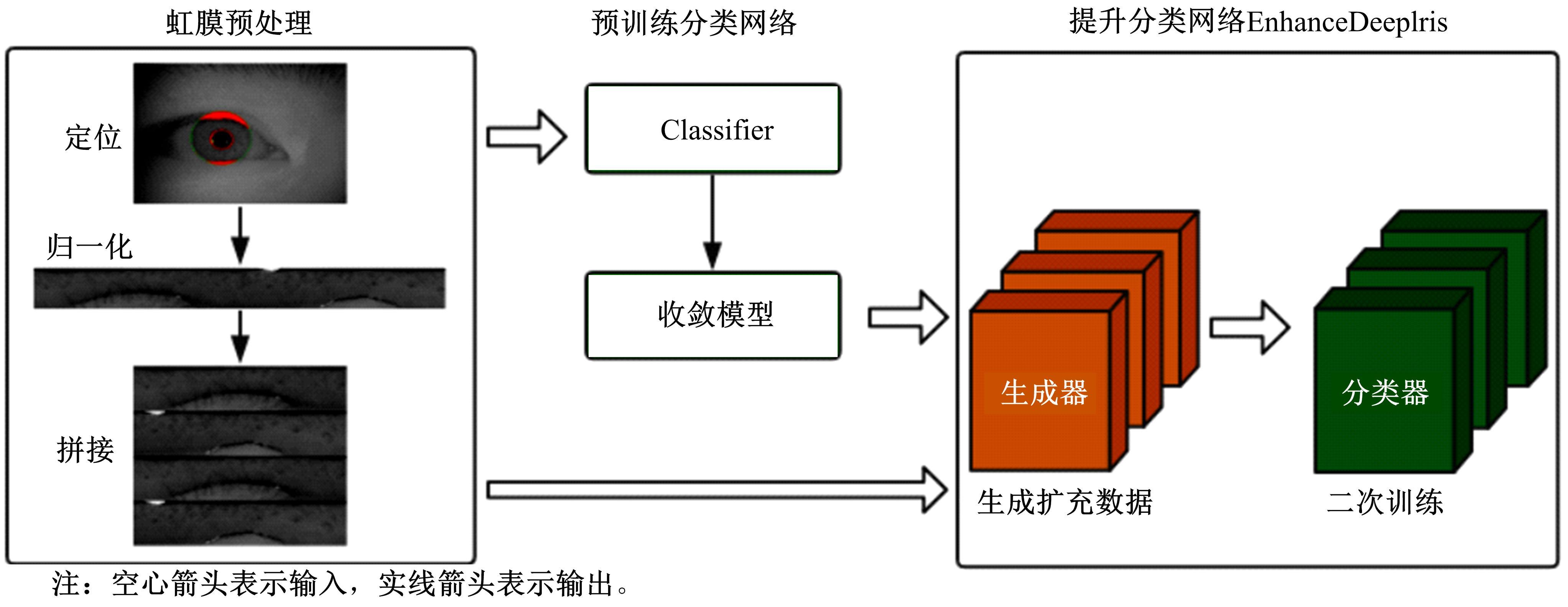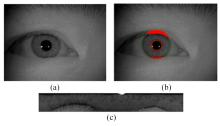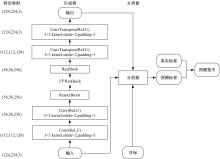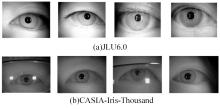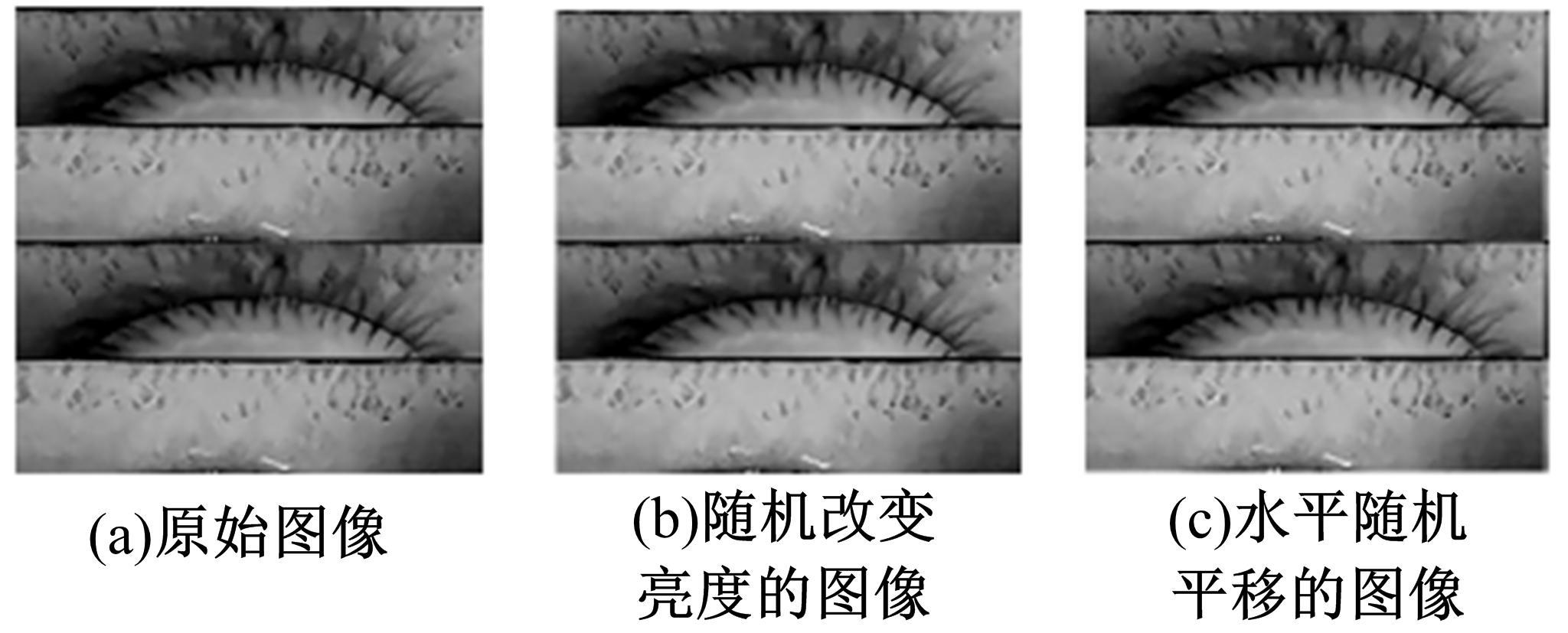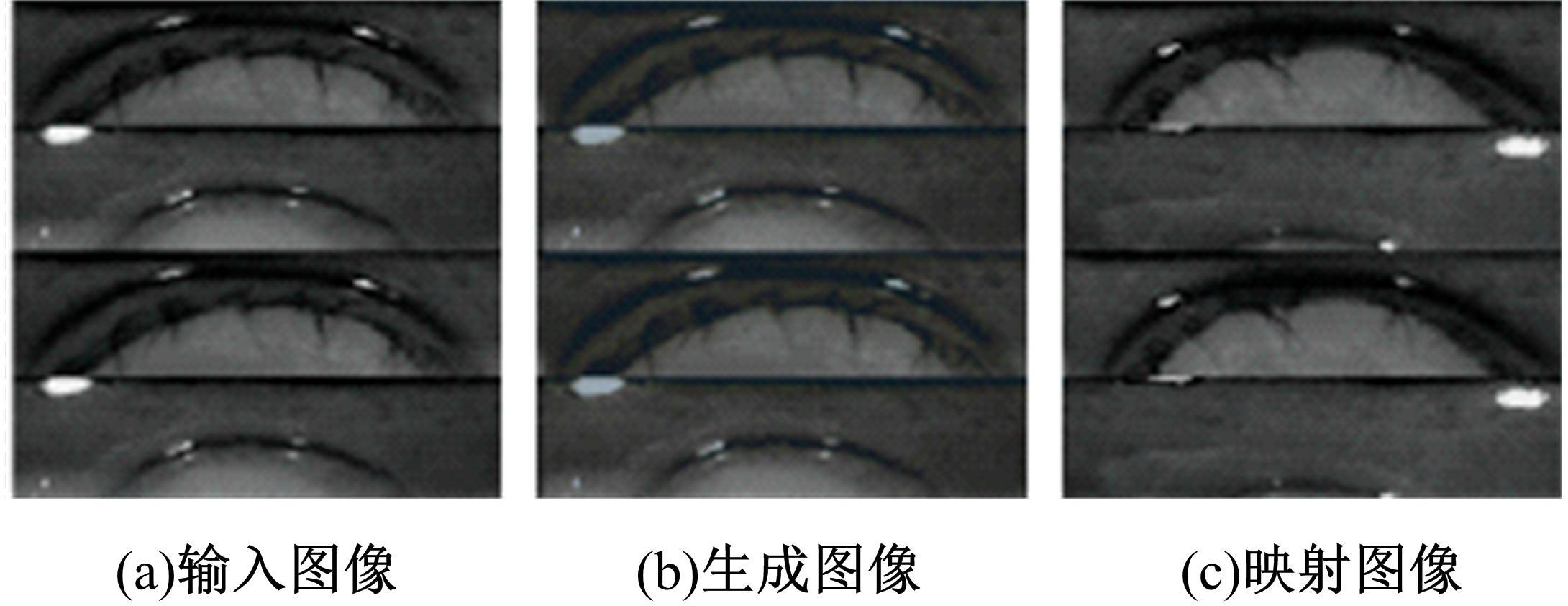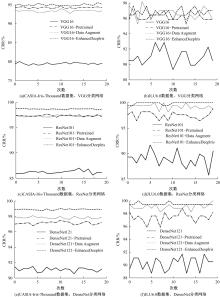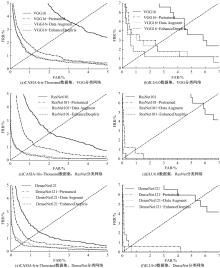Journal of Jilin University(Engineering and Technology Edition) ›› 2022, Vol. 52 ›› Issue (12): 2924-2932.doi: 10.13229/j.cnki.jdxbgxb20210438
Previous Articles Next Articles
Deep learning iris recognition method based on generative model boost training
Yuan-ning LIU1,2( ),Lin ZHU1,2,Xiao-dong ZHU1,2(
),Lin ZHU1,2,Xiao-dong ZHU1,2( ),Zhen LIU1,3,Hao-meng WU1
),Zhen LIU1,3,Hao-meng WU1
- 1.College of Computer Science and Technology,Jilin University,Changchun 130012,China
2.Key Laboratory of Symbolic Computation and Knowledge Engineering,Ministry of Education,Jilin University,Changchun 130012,China
3.Graduate School of Engineering,Nagasaki Institute of Applied Science,Nagasaki 851-0193,Japan
CLC Number:
- TP391.41
| 1 | Wildes R P. Iris recognition: an emerging biometric technology[J]. Proceedings of the IEEE, 1997, 85(9): 1348-1363. |
| 2 | Daugman J G. High confidence visual recognition of persons by a test of statistical independence[J]. IEEE Transactions on Pattern Analysis & Machine Intelligence, 1993, 15(11): 1148-1161. |
| 3 | Boles W W, Boashash B. A human identification technique using images of the iris and wavelet transform[J]. IEEE Transactions on Signal Processing, 1998, 46(4): 1185-1188. |
| 4 | Tian Qi-chuan, Pan Quan, Cheng Yong-mei, et al. Iris feature extracting algorithm based on zero-crossing detection[J]. Journal of Electronics and Information Technology, 2006, 28(8): 1452-1457. |
| 5 | Hollingsworth K P, Bowyer K W, Flynn P J. Improved iris recognition through fusion of hamming distance and fragile bit distance(article)[J]. IEEE Transactions on Pattern Analysis and Machine Intelligence, 2011, 33(12): 2465-2476. |
| 6 | 刘元宁,刘帅,朱晓冬,等. 基于高斯拉普拉斯算子与自适应优化伽柏滤波的虹膜识别[J]. 吉林大学学报:工学版, 2018, 48(5): 1606-1613. |
| Liu Yuan-ning, Liu Shuai, Zhu Xiao-dong, et al. Log operator and adaptive optimization gabor filtering for iris recognition[J]. Journal of Jilin University (Engineering and Technology Edition), 2018, 48(5): 1606-1613. | |
| 7 | 刘元宁,刘帅,朱晓冬,等. 基于决策粒子群优化与稳定纹理的虹膜二次识别[J]. 吉林大学学报:工学版, 2019, 49(4): 1329-1338. |
| Liu Yuan-ning, Liu Shuai, Zhu Xiao-dong, et al. Iris secondary recognition based on decision particle swarm optimization and stable texture[J]. Journal of Jilin University (Engineering and Technology Edition), 2019, 49(4): 1329-1338. | |
| 8 | Russakovsky O, Deng J, Su H, et al. Imagenet large scale visual recognition challenge[J]. International Journal of Computer Vision, 2015, 115(3): 211-252. |
| 9 | Krizhevsky A, Sutskever I, Hinton G. Imagenet classification with deep convolutional neural networks[J]. Communications of the ACM, 2017, 60(6): 84-90. |
| 10 | Simonyan K, Zisserman A. Very deep convolutional networks for large-scale image recognition[J/OL]. [2021-04-25]. |
| 11 | He Kai-ming, Zhang Xiang-yu, Ren Shao-qing, et al. Deep residual learning for image recognition[C]∥Proceedings of IEEE Conference on Computer Vision and Pattern Recognition (CVPR), Las Vegas, NV, USA, 2016: 770-778. |
| 12 | Huang G, Liu Z, van Der Maaten L, et al. Densely connected convolutional networks[C]∥IEEE Coference on Computer Vision and Pattern Recognition, Honolulu, HI, USA, 2017: 2261-2269. |
| 13 | Szegedy C, Liu W, Jia Y Q, et al. Going deeper with convolutions[C]∥Proceedings of IEEE Conference on Computer Vision and Pattern Recognition, Boston, MA, 2015: 1-9. |
| 14 | Liu N, Zhang M, Li H, et al. DeepIris: learning pairwise filter bank for heterogeneous iris verification[J]. Pattern Recognition Letters, 2015, 82(2): 154-161. |
| 15 | Gangwar A, Joshi A. Deepirisnet: deep iris representation with applications in iris recognition and cross-sensor iris recognition[C]∥IEEE International Conference on Image Processing, Phoenix, AZ, USA, 2016: 2301-2305. |
| 16 | Al-Waisy A S, Qahwaji R, Ipson S, et al. A multi-biometric iris recognition system based on a deep learning approach[J]. Pattern Analysis & Applications, 2018, 21(3): 783-802. |
| 17 | Zhao T, Liu Y, Huo G, et al. A deep learning iris recognition method based on capsule network architecture[J]. IEEE Access, 2019(7): 49691-49701. |
| 18 | Nguyen K, Fookes C, Ross A, et al. Iris recognition with off-the-shelf CNN features: a deep learning perspective[J]. IEEE Access, 2018(6): 18848-18855. |
| 19 | Goodfellow I J, Pouget-Abadie J, Mirza M, et al. generative adversarial networks[J]. Advances in Neural Information Processing Systems, 2014(3): 2672-2680. |
| 20 | 邹秀芳, 朱定局. 生成对抗网络研究综述[J]. 计算机系统应用, 2019, 28(11): 5-13. |
| Zou Xiu-fang, Zhu Ding-ju. Review of generative countermeasure network[J]. Computer Systems Applications, 2019, 28(11): 5-13 | |
| 21 | Zhu J Y, Park T, Isola P, et al. Unpaired image-to-image translation using cycle-consistent adversarial networks[C]∥Proceedings of the IEEE International Conference on Computer Vision (ICCV), Venice, Italy, 2017: 2242-2251. |
| 22 | Wang T C, Liu M Y, Zhu J Y, et al. High-resolution image synthesis and semantic manipulation with conditional GANS[C]∥Proceedings of the IEEE Computer Society Conference on Computer Vision & Pattern Recognition(CVPR), Salt Lake City, UT, USA, 2018: 8798-8807. |
| 23 | Liu G L, Reda F A, Shih K J, et al. Image inpainting for irregular holes using partial convolutions[C]∥European Conference on Computer Vision(ECCV), Munich, Germany, 2018: 89-105. |
| 24 | 陈英, 刘志鑫. 基于GAN的虹膜数据增强方法研究[J]. 信息通信, 2020, 214(10): 36-40. |
| Chen Ying, Liu Zhi-xin. Research on iris data enhancement method based on GAN[J]. Information & Communications, 2020, 214(10): 36-40. | |
| 25 | Waheed A, Goyal M, Gupta D, et al. Covid GAN: Data augmentation using auxiliary classifier GAN for improved covid-19 detection[J]. IEEE Access, 2020(8): 91916-91923. |
| 26 | Chinese academy of sciences institute of automation. CASIA iris image database[DB/OL]. [2021-04-30]. |
| 27 | Othman N, Dorizzi B, Garcia-Salicetti S. OSIRIS: an open source iris recognition software[J]. Pattern Recognition Letters, 2016(82): 124-131. |
| 28 | 程广涛, 巩家昌, 赵洪伟. 基于膨胀卷积和稠密连接的烟雾识别方法[J]. 计算机工程, 2020, 46(4): 253-259. |
| Cheng Guang-tao, Gong Jia-chang, Zhao Hong-wei. Smoke recognition method based on dilated convolution and dense connection[J]. Computer Engineering, 2020, 46(4): 253-259. | |
| 29 | 袁自勇, 高曙, 曹姣, 等. 基于异构图卷积网络的小样本短文本分类方法[J]. 计算机工程, 2021, 47(12): 87-94. |
| Yuan Zi-yong, Gao Shu, Cao Jiao, et al. Method for few-shot short text classification based on heterogeneous graph convolutional network[J]. Computer Engineering, 2021, 47(12): 87-94. | |
| 30 | 袁梅, 全太锋, 黄俊, 等. 基于卷积神经网络的烟雾检测[J]. 重庆邮电大学学报: 自然科学版, 2020, 32(4): 620-629. |
| Yuan Mei, Quan Tai-feng, Huang Jun, et al. Smoke detection based on convolutional neural network[J]. Journal of Chongqing University of Posts and Telecommunications (Natural Science Edition), 2020, 32(4): 620-629. | |
| 31 | 何欣, 李书琴, 刘斌. 基于多尺度残差神经网络的葡萄叶片病害识别[J]. 计算机工程, 2021, 47(5): 285-291, 300. |
| He Xin, Li Shu-qin, Liu Bin. Identification of grape leaf diseases based on multi-scale residual neural network[J]. Computer Engineering, 2021, 47(5): 285-291, 300. | |
| 32 | 李新春,马红艳,林森.基于局部邻域四值模式的掌纹掌脉融合识别[J].重庆邮电大学学报: 自然科学版, 2020, 32(4): 630-638. |
| Li Xin-chun, Ma Hong-yan, Lin Sen. Palmprint and palm vein fusion recognition based on local neighbor quaternary pattern[J]. Journal of Chongqing University of Posts and Telecommunications (Natural Science Edition), 2021, 47(5): 285-291, 300. |
| [1] | Xian-yu QI,Wei WANG,Lin WANG,Yu-fei ZHAO,Yan-peng DONG. Semantic topological map building with object semantic grid map [J]. Journal of Jilin University(Engineering and Technology Edition), 2023, 53(2): 569-575. |
| [2] | Xiao-hu SHI,Jia-qi WU,Chun-guo WU,Shi CHENG,Xiao-hui WENG,Zhi-yong CHANG. Residual network based curve enhanced lane detection method [J]. Journal of Jilin University(Engineering and Technology Edition), 2023, 53(2): 584-592. |
| [3] | Peng GUO,Wen-chao ZHAO,Kun LEI. Dual⁃resource constrained flexible job shop optimal scheduling based on an improved Jaya algorithm [J]. Journal of Jilin University(Engineering and Technology Edition), 2023, 53(2): 480-487. |
| [4] | Jin-Zhen Liu,Guo-Hui Gao,Hui Xiong. Multi⁃scale attention network for brain tissue segmentation [J]. Journal of Jilin University(Engineering and Technology Edition), 2023, 53(2): 576-583. |
| [5] | Jin-wu GAO,Zhi-huan JIA,Xiang-yang WANG,Hao XING. Degradation trend prediction of proton exchange membrane fuel cell based on PSO⁃LSTM [J]. Journal of Jilin University(Engineering and Technology Edition), 2022, 52(9): 2192-2202. |
| [6] | Feng-feng ZHOU,Hai-yang ZHU. SEE: sense EEG⁃based emotion algorithm via three⁃step feature selection strategy [J]. Journal of Jilin University(Engineering and Technology Edition), 2022, 52(8): 1834-1841. |
| [7] | Xuan-jing SHEN,Xue-feng ZHANG,Yu WANG,Yu-bo JIN. Multi⁃focus image fusion algorithm based on pixel⁃level convolutional neural network [J]. Journal of Jilin University(Engineering and Technology Edition), 2022, 52(8): 1857-1864. |
| [8] | Fu-heng QU,Tian-yu DING,Yang LU,Yong YANG,Ya-ting HU. Fast image codeword search algorithm based on neighborhood similarity [J]. Journal of Jilin University(Engineering and Technology Edition), 2022, 52(8): 1865-1871. |
| [9] | Tian BAI,Ming-wei XU,Si-ming LIU,Ji-an ZHANG,Zhe WANG. Dispute focus identification of pleading text based on deep neural network [J]. Journal of Jilin University(Engineering and Technology Edition), 2022, 52(8): 1872-1880. |
| [10] | Xiao-ying LI,Ming YANG,Rui QUAN,Bao-hua TAN. Unbalanced text classification method based on deep learning [J]. Journal of Jilin University(Engineering and Technology Edition), 2022, 52(8): 1889-1895. |
| [11] | Gui-he QIN,Jun-feng HUANG,Ming-hui SUN. Text input based on two⁃handed keyboard in virtual environment [J]. Journal of Jilin University(Engineering and Technology Edition), 2022, 52(8): 1881-1888. |
| [12] | Dan HU,Xin MENG. Vessel search method by earth observation satellite based on time⁃varying grid [J]. Journal of Jilin University(Engineering and Technology Edition), 2022, 52(8): 1896-1903. |
| [13] | Jun WANG,Yan-hui XU,Li LI. Data fusion privacy protection method with low energy consumption and integrity verification [J]. Journal of Jilin University(Engineering and Technology Edition), 2022, 52(7): 1657-1665. |
| [14] | Feng-feng ZHOU,Yi-chi ZHANG. Unsupervised feature engineering algorithm BioSAE based on sparse autoencoder [J]. Journal of Jilin University(Engineering and Technology Edition), 2022, 52(7): 1645-1656. |
| [15] | Ming-hua GAO,Can YANG. Traffic target detection method based on improved convolution neural network [J]. Journal of Jilin University(Engineering and Technology Edition), 2022, 52(6): 1353-1361. |
|

